
| WWT Shows | CLICK TO: Join and Support Internet Horology Club 185™ | IHC185™ Forums |

|
• Check Out Our... • • TWO Book Offer! • |
Welcome Aboard IHC185™  Internet Horology Club 185
Internet Horology Club 185  IHC185™ Discussion Site Main Page
IHC185™ Discussion Site Main Page  Open to the World RESEARCH FORUMS
Open to the World RESEARCH FORUMS  Hamilton and 992B Research Forum
Hamilton and 992B Research Forum  992B cases: designs
992B cases: designs
 Internet Horology Club 185
Internet Horology Club 185  IHC185™ Discussion Site Main Page
IHC185™ Discussion Site Main Page  Open to the World RESEARCH FORUMS
Open to the World RESEARCH FORUMS  Hamilton and 992B Research Forum
Hamilton and 992B Research Forum  992B cases: designs
992B cases: designsGo  | New Topic  | Find-Or-Search  | Notify  | Tools  | Reply to Post  |  |
My interest in these watches is strongest regarding the cases. Specifically-does anyone have any documentation as the whether case model #11 with the winged wheels design is meant to allude to the Southern Pacific Railway's "Daylight" streamliners?? RR case model 10 surely suggests similarities to Cincinnati Union Terminal. This is all conjecture on my part, but there's got to be something to it. I do know for a fact (as told me years ago by a Milwaukee Road official) that a certain Elgin 571 B W Raymond (Can't recall model #) was marketed with a design that corresponded to the design of the Hiawatha Streamliners. | |||
|
Hasn't it occurred to anyone that railroad watches are connected to RAILROADS??? The era of timetable control and telegraph and time service isn't that long ago. There's no end to the apparently fascinating subject of all the wonderful ways to mark "992B" on a 992B. This is so much navel gazing. Like the railfans who get so enthralled when the see an obsolete radiator hood on an old diesel but don't seem to know that the railroaders themselves don't care and are somehow more interested in moving freight. | ||||
|
William, I have never thought of where the basic design came from and if it was tied into certain archecture.... | ||||
|
| IHC President Life Member |
You make some excellent points William, much of the design significance is lost on most of us today. There is little left of the influences that were all around them in those by-gone years. Without question, winged wheels on the Case 11 made a statement and you may have pegged their origins. And speaking of the Model 11 Case those appear to be locomotive brake-wheels depicted on either side of the bow. The image below is of Larry Burwell's amazing C039 low serial number example. Read that topic carefully we had some fun with Larry in that one. Case 11 is an example of design depicting motion... 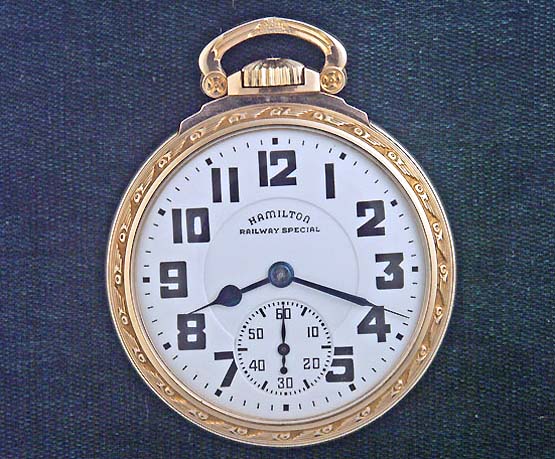 | |||
|
Does anyone know whether Bunn Special Model 29 cases were intended to depict a similar theme? | ||||
|
Here we have the Hamilton #11 and Bunn Special #29 side-by-side with similar bezel designs. Robert 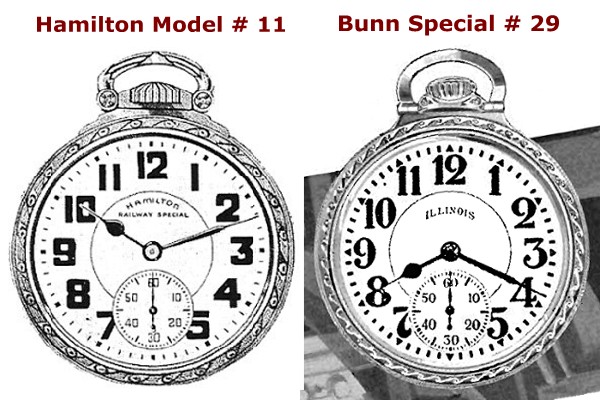 | ||||
|
Thank you for the excellent side-by-side comparison, Robert. I've yet to see a model 29 case in person, so I was wondering whether those were waves, wheels (like the #11), or otherwise on its bezel. | ||||
|
Wesley, Below is the pendant area of a #29. We may need to start a new topic, as we are getting into Bunn Special information. Hope this helps. Robert 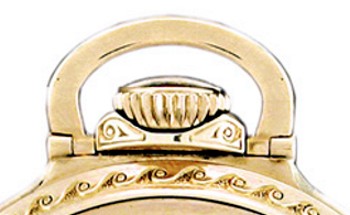 | ||||
|
| IHC President Life Member |
Very interesting topic! Taking this a bit further, the same style back and bezel design used on the Model 29 Bunn Special case also shows up on the Model 193 Sangamo Special case. Closer details of the Model 193 which were used on some Marked Sixty-Hour Sangamo Specials are shown in the image below this message. Interestingly the Model 29 and the 193 were made by Wadsworth beginning in 1929 and although Keystone first produced the Case 11 in 1940 I agree with Wesley that certain design characteristics do at least seem similar. Close-up on a Wadsworth Sangamo Special Model 193 case... | |||
|
Megger referred to the model 29 bezel design as "breakers" seems purely abstact decorative and not referential. However the Sangamo Special stiff or rigid bow case and the bow pictured above display the Roman fasces design common in the 1920s (Look at the Mercury dime). Back to RR cases, here are some ideas: look at Hamilton case model 10 and a picture of Cincinnati Union Terminal, or Elgin 571 B W Raymonds with Milwaukee Road streamliners, use a little imagination, think like designers and marketing people,and maybe listen to some Glenn Miller while your at it. | ||||
|
Follow up on my previous post- look at your Hamilton model 4 or similar Fahys RR case , or the first Elgin "ELGIN RR" case, you will notice bezel design suggesting ties and ballast (seen edgewise) For me this is the fascination of the railroad watch case and that whole era. Truthfully, though I'm aware of the variations all 992B movements look pretty much the same to me. | ||||
|
| IHC Life Member |
Permit me to chime in 3 years late. There have been several discussions as to the inspiration for the design on the Model 11 case. As fans of specific railroads we can be disposed to thinking the designs are inspired by those companies. When the model 11 case was designed America's railroads were deep into the promotion of their streamliners, and diesel locomotives. When I first saw a Model 11 case in 1965 at age 14 I got the notion that this was a "Western" design. It could be said that the bezel design was inspired by Southern Pacific's herald for the "Daylight" Streamliner. It could also be, and has been, said that the design was inspired by Santa Fe's Indian herald on the sides of their passenger diesel power. I feel that the design group at Hamilton would not want to show favoritism towards any one specific line as that would create a void from the competiting railroad. No one on the Santa Fe would strut around with a new watch that they felt honored the Southern Pacific and vice versa. As speed was paramount in that era, and the streamliners back then were already traveling in excess of 100 mph in some instances, it's my opinion as a designer that the design represents a winged wheel of speed. As for the wheel on the bow it is further my opinion that it's not a brake wheel on a locomotive. I'm not an expert on steam power so I took a look at my Locomotive Builders' Cyclopedia from 1941. It seems that all hand brakes for steam power were located on the tender. Those hand brake mechanisms were of the lever type instead of a hand brake wheel found on freight cars. Hand brakes on freight cars were of the wheel variety as they had to be operated by a brakeman standing on a small platform while the car was in motion during certain switching (or drilling in the east) manuvers. In the real old days a brakeman would have to insert a "club" into the spokes of a brake wheel in order to fully apply them. With a bezel design that is supposed to represent speed in a time in railroad history that is proud of this achievement, an additional design element, in a prominent position of the work would not be one to represent a device used on a freight car used for stopping, applied by a brakeman. In the cab of modern steam power was a wheel that sat right in front of the engineman. Some children's books mistakenly identified this as a steering wheel. But it's the reverse wheel. This was adjusted for the steam pressure and to reverse the engine. A design that would reflect a reverse move would also be out of the question. So it's merely my opinion that the bow design is a further reflection on the speeding winged wheel. Perhaps it's the fast turning driving wheels of a high speed passenger steam locomotive. We'll never know for sure. As for the influence on the Model 10 case by Cincinnati Union Station we have to keep in mind that both of them were based on popular design elements of the time, not each other. | |||
|
| IHC Vice President Pitfalls Moderator IHC Life Member |
Since the late 19th century, the primary means of railroad braking has been the air brakes on each car (see picture). Some of the case designs have elements that suggest the brake shoes against the wheels. The brakes were applied by the engineer by means of a lever-operated valve in the cab of the locomotive. Typical Railroad Air Brake | |||
|
| IHC Life Member |
Air brakes are for stopping a train, or in the case of motive power,operating by itself the independant brake is used. The independant brake my be held in release while the train brakes, or automatic brake, is set. Thereby stretching the slack and bringing a heavy freight train to a stop, or slowing it down. But to be more specific every railroad car in America, to this day, is equiped with a hand brake. If a car, or cut of cars are set out on a siding the hand brakes on one or more cars is set to keep the equipment from moving. If the cars were left with merely the airbrakes applied, said brake pressure eventually leaks off and the brakes release. When any equipment is layed up the hand brakes are applied. In switching operations where a car is kicked, or dropped a brakeman, at least in my time, would have to "Ride the brake," and stop the car at a specific spot by operating the hand brake with a brake wheel. The next time you're stopped by a freight train at a railroad crossing look at the ends of the cars. You'll see a brake wheel. | |||
|
| IHC Vice President Pitfalls Moderator IHC Life Member |
That's right Mitch, the hand brake on a rail car is sort of like the parking brake on your car, mainly for preventing a stopped vehicle from rolling. In the days before Westinghouse invented the air brake, that was all they had. So you always had brakemen scurrying along the tops of moving trains, setting or releasing the hand brakes on all the cars, as directed by signals from the engineer. Best Regards, Ed | |||
|
| IHC Life Member |
And for you kids just tuning in from this century, and the precious ebay community those signals were from the engine's whistle. Freight trains weren't very long back in the pre-Westinghouse days. Brakemen would have to climb the grab irons and ladders and "decorate" the top of the train. A brakeman would have to set the brakes on more than one car. He would have to walk the roof walk on a moving train, in the snow, and jump over the gap, one car to the next. And we used to wonder why old trainmen were so crabby. It took a lot of seniority for a trainman to hold a job on "the varnish,*" or passenger trains. One could operate the handbrakes from the platform on the coaches. * The 'varnish" was a slang term used up until 1982 that I can atest to, for passenger trains. The term comes from the way wooden passenger cars were finished. They weren't really painted. A special type of heavy varnish, with the consistency of clay, was applied in layers to seal and coat the wood. Each succeeding layer was buffed smooth so when the car was finished, it was "varnished." | |||
|
I can recall standing on top of a moving box car waving signals to an engineer in a switch engine about 300 yards away with a fusee throwing sparks that burned holes in my hat. That was pretty exciting work. | ||||
|
Actually, the swirling design you see on the model 29 has been expressed universally since ancient times as representing water. No wonder it was called "breakers." What does this have to do with the railroad? I think it's just a pleasant design. | ||||
|
| IHC Life Member |
Steve and the gang, Designs such sa "The Breakers" were popular in the late '20s into the late '30s." Then came the outer space look. I remeber coming in two (when a train breaks a knuckle (part of a coupler,) or just comes un-coupled.back in the summer of '69. The hind end (rear) got stopped right over the high bridge over the Fox River. We had to shove back (make a reverse move) to get the train back together. I was wearing cloth gloves and climbed the ladder of a boxcar. I lit the fusee (flare) and gave a big back-up sign (waving the fusee in a big circle.) As we were shoving back about 20 mph, and I was holding the fusee, my glove caught fire...and so did my hand. I waved a huge wash-out (stop signal) and got the move stopped. We ended up right on the end of the bridge. I got the fire put out and went down to the river to soak my hand. I'm OK now, 40 years later, but I'll never forget it. And there I was, big hero of the rails with my 992B on a heavy chain stretched across my work shirt. | |||
|
Great input, Mitch, never too late. I did my apprenticeship in watch repair (informally) under a Soo Line watch inspector next to the Shoreham Shops in Mpls. I got exposed to the 992B early on there and was intrigued by the cases above all else and picked up the notion of railroad designed cases then. If you ever get up here to Mn I should give you a tour of our railroad ghosts. This fall our annual steam excursion down the Mississippi River will feature the Southern Pacific #4449 on the head end. I'll carry my model 11 and get some opinions! | ||||
|
| IHC Life Member |
William, If you ride that trip with the 4449 you'll bump into a lot of my friends. They're all going. For me fan trips are just that. A fan trip. I miss real railroading. I remember the first time I worked up to Minneapolis on a passenger job when I was on the Milwaukee Road. I stayed overnight at the home of close friends of the family. He had been my uncle's best friend and was an engineman on the IC (Waltham Vanguard, 23 jewels.) He took the call from the caller that next morning and said, "They still have the same sound to their voice when they call ya." | |||
|
It may be only a fan trip (with more than a few foamers), but the CPR is a good host. We get priority over everything except Amtrak and coal. My wife and I and the in-laws will be in the Super Dome | ||||
|
| IHC Life Member |
I have nothing against fan trips, foamers, daisy pickers, and the folks selling back issues of Trains Magazine, etc. I've been the conductor on some, the engineer on others and the like. Just once I'd like to see a complete consist of matching equipment, with a real diner and lounge, and a cranky old train crew to tell us to shut the Dutch doors. | |||
|
Off topic here, but the Friends of the 261 will eventually have a complete matching consist as funds permit. Some cars are on storage tracks, have paint job done, need interior and mechanical work . Getting the super dome and observation car really helped. Normally I carry an Elgin 571 BWR, streamlined case of the Hiawatha era. At one time I had a nearly complete collection of railroad type cases. | ||||
|
| Railway Historian IHC Life Member Site Moderator |
I was reading through some of these old threads, and noticed Lindell's reply about the Hamilton Model 11 case bow, and the wheel shaped discs on each side, looking like locomotive brake wheels from the steam locomotives of that era. Mitch Markovitz, answered three years later in 2009 "that it's not a brake wheel on a locomotive. I'm not an expert on steam power so I took a look at my Locomotive Builders Cyclopedia from 1941. It seems that all handbrakes for steam power were located on the tender. Those hand brake were of the lever type instead of a hand brake wheel found on freight cars" Well here we are another three years later and I will clarify what was used in the steam era for securing a steam locomotive like the CN 6068 a Mountain type steam locomotive built by the Montréal Locomotive Works in 1944, pictured here running last summer August 1, in Big Valley, Alberta 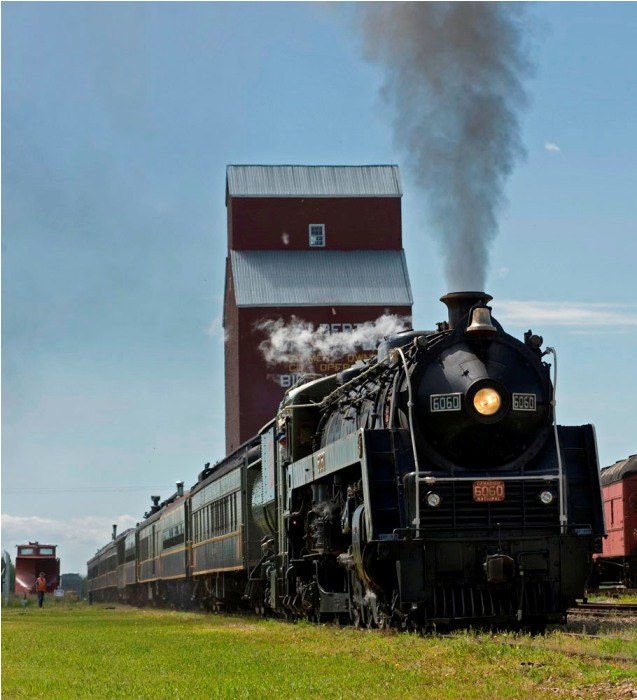 | |||
|
| Railway Historian IHC Life Member Site Moderator |
Mitch was correct in a statement about locomotive tenders having lever type hand brakes, but they were only used when the steam locomotive was detached from the tender for repairs, or servicing, drive wheels on the steam locomotive cannot be secured with handbrakes, especially since steam locomotives, unlike their diesel locomotive successors that could be isolated electrically from the driving wheels, steam locomotives under pressure had a tendency for the steam throttle to leak, causing them to unintentionally creep away at times with disastrous results. 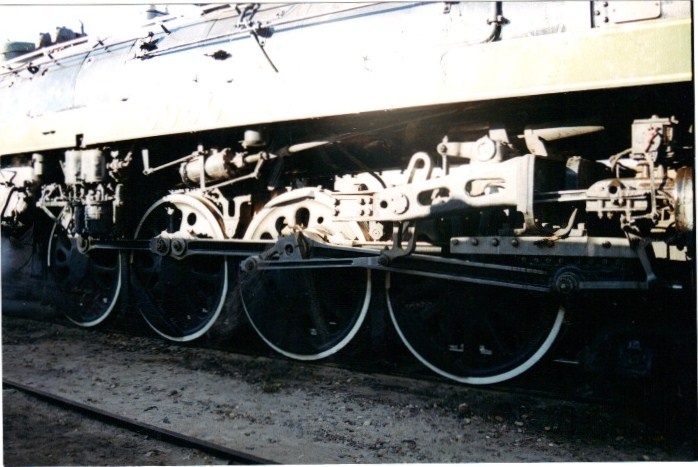 | |||
|
| Railway Historian IHC Life Member Site Moderator |
What was the answer, it was very simple a length of chain, called a snubbing chain was tossed around the drive wheel of the steam locomotive, immobilizing it from moving forwards or backwards. Don Towle an old steam locomotive engineer I used to work with, told me his experiences working as a passenger fireman between Calgary and Edmonton Alberta, on the CPR back in the 1940s. When they made a stop to pick up or discharge passengers and freight, and he was outside doing his duties of oiling, or attending to the grates on the firebox, the old engineer he working with would get the signal from the passenger conductor to leave town would start to leave town whether Don was on board or not he didn't care. After a couple of incidents like this having to chase the locomotive and jump on board before he got going too fast, Don figured out how to make his life easier, whenever they made a passenger stop he would put a railroad spike wedged under the drivers, and the stop the practice, when he was ready to go he would remove the spike, and climb on board and the way they would go. 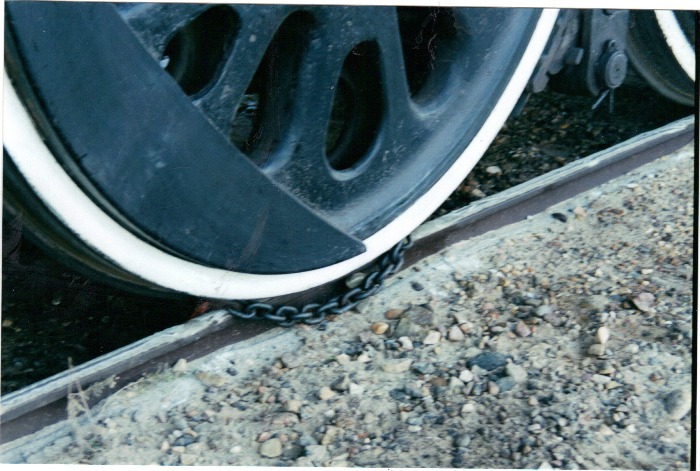 | |||
|
| IHC Member 1369 |
Hi Larry, thanks for this chain story. Being a model railway guy I always love to hear real anecdotes like this. Great! | |||
|
| Powered by Social Strata |
| Your request is being processed... |
|
©2002-2025 Internet Horology Club 185™ - Lindell V. Riddle President - All Rights Reserved Worldwide

